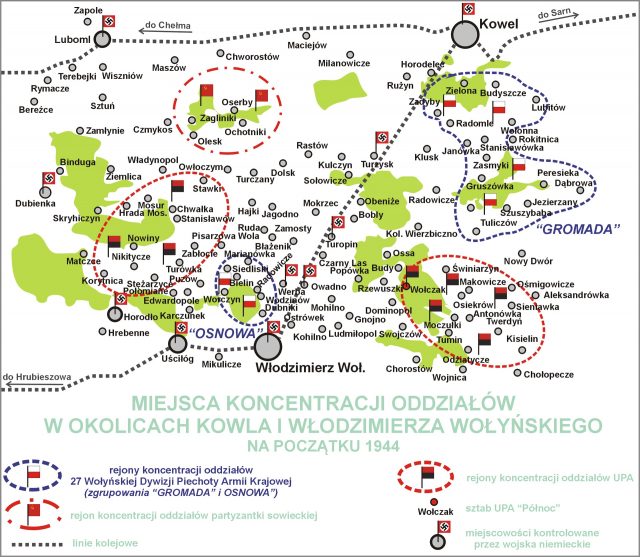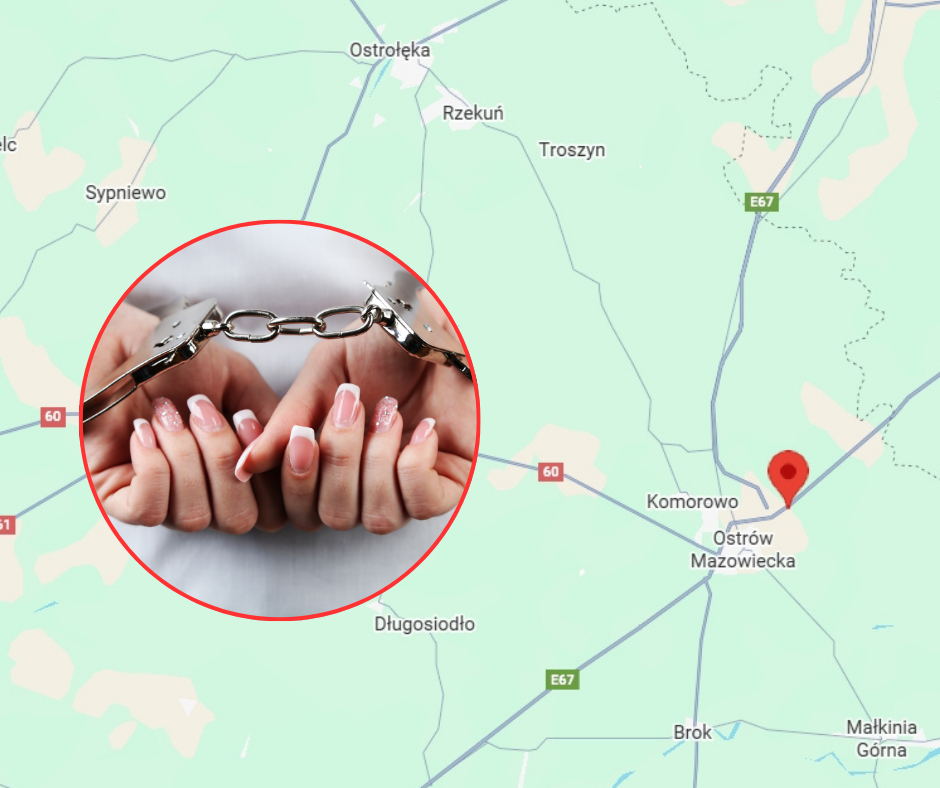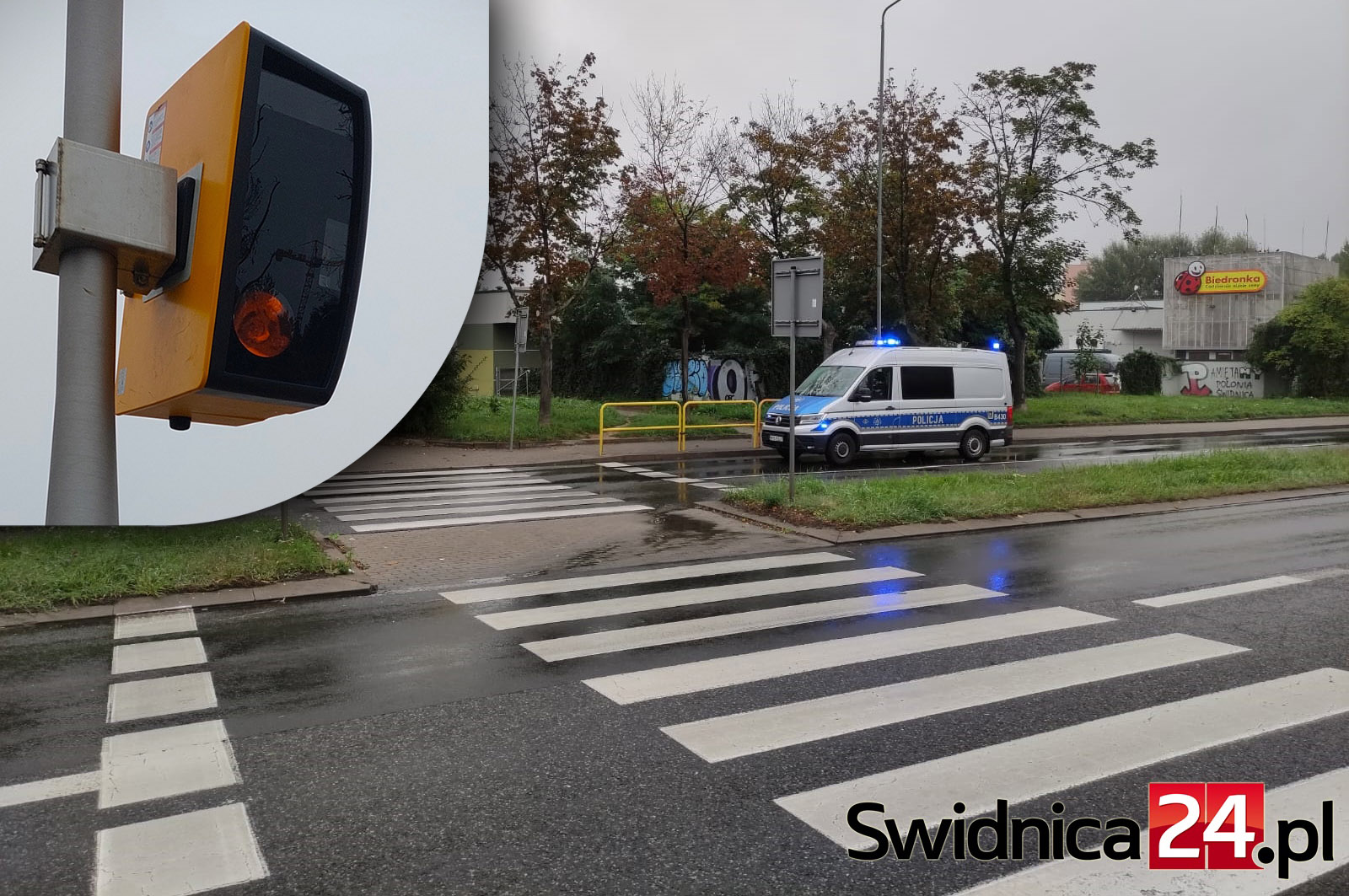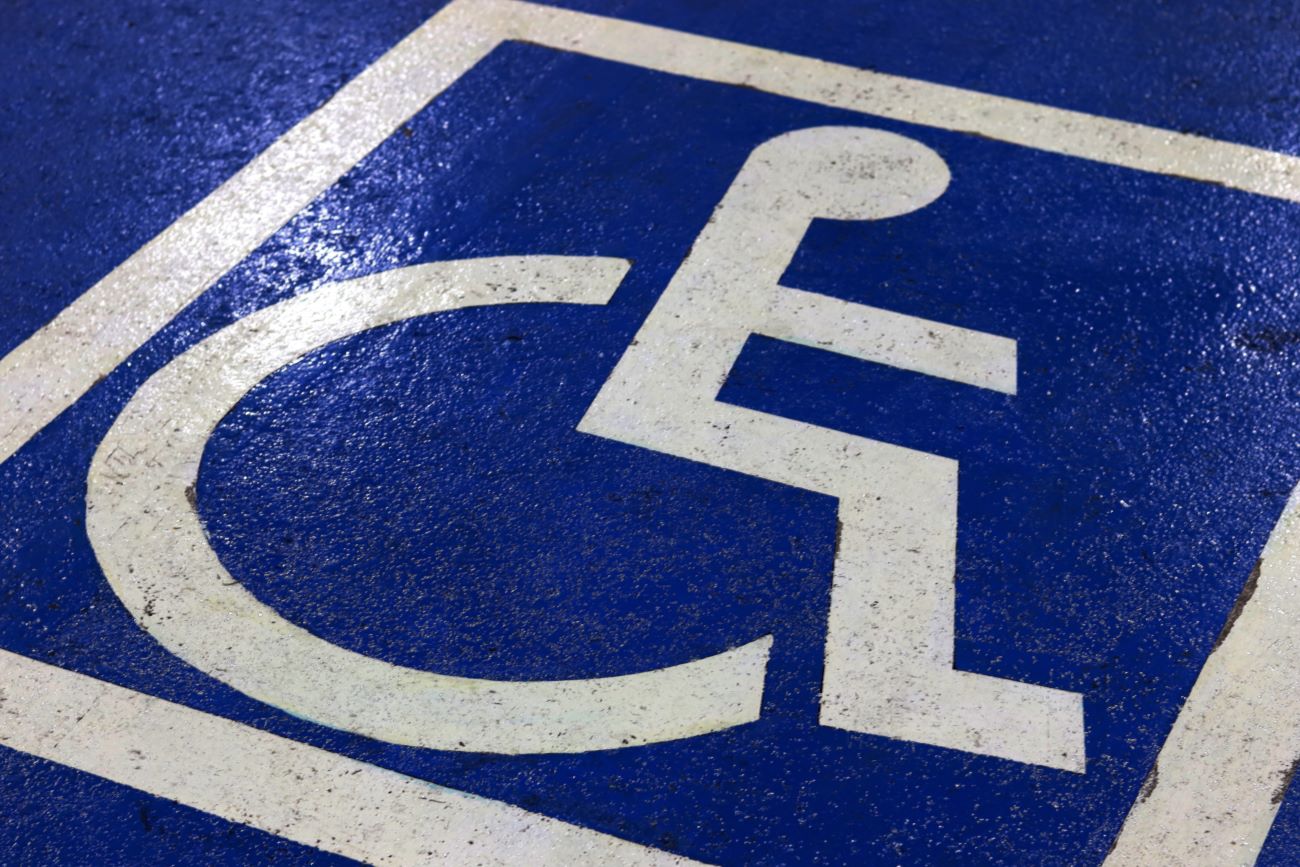The operation of the Volyn territory of the AK in 1943 went in 2 directions: the creation of strong self-defense bases and strong guerrilla troops, interacting with the defence of the bases. Unfortunately, self-defense was late.
The area of activities of the 27th Division included the districts Kowel Luboml and Włodzimierz Wołyński. In the remaining 8 counties, if Poles had not escaped to Przebraz, the Old Huta, the Lord's Valley, they were murdered by UPA troops assisted by the local Ukrainian population.
In the first half of July 1943, he arrived in Zasmyk Lt. Henryk Nadratowski ps. “Znicz” - The civilian commander of self-defense. On July 16th, an armed force arrived Lt. Władysława Czermiński ps. “The Hawk“ and on August 19, a second officer arrived (silent) Lt Michał Fijałka ps. “Sokół”. These troops collaborated with the Zamyk base, to which Poles arrived saved from pogroms. The large Patriotic War continued far in the East, and Poles were forced to fight to the death.
The request for medical assistance to fight soldiers and wounded during UPA robberies forced the organization of wellness services. In the base of self-defense in Zasmyki, the punk sanitary site was already active in July 1943. The nurses worked there: Janina Szmagalska, Janina Włodarska and a paramedic Edward Kiikkowski. Initially, the point was located in a private apartment. During successive acts of panic of Ukrainian nationalists wounded arrived. They were placed in the school rooms. The memorable tragic shepherdess of 1943 consumed 48 victims. Upodists dressed in German uniforms, insidiously assaulted Janówka, Stanisławówka and Radomle-colonies belonging to the base's defence strategy in Zasmyki.
Germany, in the face of the imminent failure of the East, drew additional forces and began carrying out mad pacification actions throughout Volyn. The goal was to destruct guerrilla troops and civilians who supported them. On 19 January 1944, they pacified Zamyki. 38 buildings burned down, supplies accumulated for the winter, people left homeless.
In the first days of January, the troops of the First Ukrainian Front broke the German defence section on the Horyń River, crossed the Polish borders from 1939 and occupied the Volyn area with a large wedge. In mid-January 1944, the commander of the AK-Wołyń territory issued a mobilization order and moved the location of the underground staff halt from Kowla to Kupniczów. On 16 January 1944, young people from cities came out of the conspiracy without weapons, many women arrived, certified nurses, liaisons, encrypts. There were 500 women in the cells of the AK conspiracy. Something breathtaking began to happen, something that was said about, and this in turn stimulated the imagination of young girls to start a war. The tasks in the “Burza” action were precisiond.
In a shocking situation, erstwhile common antagonisms were already governed by the laws of war, of course a provoked war and reached the apogee, forces were joined to face destiny, not to share the function of UPA convicts or the destiny of German slaves, officially supplied for forced labour by Arbeitsamt. erstwhile the chance for active work arose, the girls took it, reasoning it was a sacred duty. And so they no longer had youth, she was savagely taken from them by the banders and Germans. Mothers understood this necessity, looked at the lenient eye, and did not defend themselves from engaging in works intended to survive. There was frost, the earth was fossilized, what could be done – nothing, the war took distant the children's parents and carried into a terrible planet of fighting, dangerous, deadly, but saving. It included a full increasing generation of border Poles.
The merchants were a large village inhabited mainly by the Czechs, kindly referring to Poles. This village was overrun by Polish guerrilla troops in mid-1943 and was, alongside the close Zasmik, a large self-defense centre, providing shelter for Czechs, Poles and just Ukrainians. The territory chief ordered the establishment of the main medical institution - the division field infirmary in this town, assigning a building of erstwhile municipal authorities to its needs. The infirmary in Kurzyczów began to be organized on the basis of a part of staff posted from the sanitary station operating in Zasmyka. It was directed by an experienced felcher Miron Antonovich Niemochalenko
This facility rapidly reached the standards of a full developed field division hospital. peculiar merits in its creation were laid: the Lieutenant Doctor arrived from Warsaw Grzegorz Fedorowski ‘Grif’, Commander of the Merchant self-defense lieutenant Wilhelm Skomerowski "Wolczur” and a conspiracy activist from Kowla Kazimiera Balysz “Mira” which included the hard administration of the hospital. In his uprising and activities, the staff of the territory infirmary in Kowl, led by the Lieutenant Doctor Vladimir Zagórski "Eight". He was co-founder of the conspiracy in this area and has served as head of sanitary service of the AK Kowel territory Inspectorate since its inception. erstwhile the “Gromad” group began to be organized, he was appointed head of wellness care. Under his direction, sanitary facilities were established in all self-defense centres within the territory of that inspectorate. As a infirmary director, he supported the work of these points as far as he could, directing qualified sanitary staff to them and providing basic medical tools and materials. In the infirmary he managed from 1942 to 1943, the paramedics' courses were conducted, whose graduates later served in self-defense centers, guerrilla troops, as well as in the battalions of the Volyn infantry division.
He appointed an experienced surgeon's lieutenant as the commander of the merchant infirmary Sigismund Simbierowicz ps. “Zyg” from Koširski Stone. Many concerns about the establishment and smooth functioning of this infirmary were besides demonstrated by the head of wellness care of the 27th WDP AK, Lieutenant Doctor Jan Matulewicz. From the Kowel infirmary they went to work in the field infirmary in Kurzyczów among others: the Superior Sister Maria Walczak “Bogna”, who led auxiliary staff in Merchant; caregiver Halina Grochowska ‘Irys” and medical student and same - sacrificing sister Maria Wójcik. Most of the merchant hospital's paramedics were scouts, trained earlier in the sanitary course, including: Kazimiera Błaszczyk “Kicia”, Ewa Piłkowska “Kalina”, Janina Walczakina “Szarotka”, Henryk Rykowska “Pchelka“ My Mom Monika Śladewska ‘Halina” (photo), Bożena Frankowska “Rusałka”, Irena Zawada-Gawdzik “Stoprostka”, Bożena Imiałkowska “Bożena”, Janina Mrozówna, Maria Ilczuk “Maczek”, Jadwiga Jagodzińska “Pączek”, Janina Ciemiorska “Jaskółka”, Zofia Kubikowska “Brygida”, Stanisław Paszko “Nela” and Janina Teder “Kalina”, Zosia Municzewska “Astra”, Janina Żmijewska ps. “Dzwonecki”After the course, she left for the Grey branch.

Zosia Żolnik, Ice Czechowska and others worked at the infirmary in Zasmyki. Mom was besides in contact with her cousin Sulence Veronica ps. “The MagpieIt’s okay. ” In general, 21 paramedics served in this hospital. Many another girls worked there as maids, kitchen aids, and infirmary laundry. As a consequence of their hard work in the destroyed building, a infirmary was created, consisting of 3 clean and neat rooms for the sick, containing more than 20 white, metallic beds with night cabinets or rolling stock. The beds were covered with white sheets and blankets. A doctor’s office was arranged next to the rooms, which is besides a treatment room, as well as a kitchen and a pantry. The comparatively modest equipment of the infirmary was completed at the end of February. It was then that respective carriages with equipment of the infirmary from Lubomla, evacuated by the Germans, were located at the Ja hours station.
In consultation with the manager of this hospital, the doctor Stanislaw Lorence, AK members working at the station transfused the wagons to the siding where they were landed. The medical tools, medicines and dressings obtained in this way were transported to the guerrilla lieutenant's unit Kazimierz Filipowicz "Korda” and was then handed over to the head of the divisional wellness department, which divided them between the field hospitals and sanitary sections in the combat wards. This improved the medical supplies in the division. At the time, so many individual dressings were collected that all linear soldier was equipped with them. These dressings, hermetically sealed in tin boxes, were guarded and valued by soldiers on equal terms with ammunition. In March, the influx of wounded was so large that they did not fit in the hospital. The trained soldiers were then sent to their families or to their home troops to release the infirmary facilities needed. For the lighter wounded, suitable rooms were sought among the inhabitants of Kurzyczów, providing them with constant infirmary care
The constant bombing of German aircraft was oppressive and burdensome. During the raids, the full staff of the infirmary with large effort came from the injured building, looking for a safe place for them, and after their completion with a large amount of work they restored the erstwhile condition. The Germans most frequently dropped storming and incendiary bombs, which caused quite a few damage, forcing infirmary staff to carry out continuous repair work. 1 of the biggest ailments among the guerrillas was the pigs. As the number of patients increased rapidly, it was decided to produce ointments against chives, which were sent to wards that organised their own fight against this disease. The ointment was effective, since in many branches the illness was eliminated.
It was much more hard to exterminate than it was to control all branches. Its improvement was encouraged by the everyday lifestyle of guerrillas, in which the elements dominated specified as: continuous activity in the field, frequently from early morning to late evening, sweaty underwear which was hard to change, sleeping in clothes – dirty and worn-out, deficiency of time and anticipation of bathing, especially in winter. Of course, many actions were taken against the disease, but only short-term effects were achieved. Wszewa has sometimes been a prerequisite for the improvement of another diseases, especially spotted (outer) durus. This severe infectious illness occurred in many guerrilla troops, and most affected soldiers from the captain's ward Władysław Kochanski “Bomby”, who came to the group “Gromady” after crossing respective twelve kilometres, marching all the way from Kostopola.

Of the little than 200 soldiers in this branch, respective twelve have contracted this dangerous disease. Individual cases have occurred in others. respective russian partisans from close troops were besides asked for medical help. In Nyry village close Kupyczów and in Rzewuszki, separate hospitals were organized for them, in which doctors and, above all, respective sacrificial paramedics with sister Janina Włodarska “Dana” at the head, carried out appropriate treatment. Doctors warned that lice and dirt were typhus, so the effectiveness of fighting this illness was to remove its sources. This was highly hard in the mass of people who found themselves in specified unfavorable, primitive hygiene conditions. A steam bath was organized in the base and an oven was set up by it, in which the clothes of healthy and sick soldiers were disinfected. There was a laundry area on site, so patients were frequently changed undergarments and consistently controlled by individual hygiene. This infirmary was isolated from its surroundings by fenced it and its surroundings by defender posts. No 1 was allowed in or out. These treatments avoided the spread of the disease.
Theoretic cognition of the paramedics was gained at respective hours of lectures conducted regular by Dr. “Griff” and Dr. “Sęp”. These classes afraid the basics of injury pathology, wounds, care and first aid in the event of injury, hemorrhaging and removal of wounded from the battlefield. In the hospital, they mastered the method of intramuscular injections, bandages, wound dressing, disinfection, and bubble setting. The training was mainly applicable and required quite a few commitment. The doctors were happy with the progress, they had hopes. Dr. “Grif” claimed that in his practice he had not yet had specified willing and capable students. The girls tried to meet their assignments, and they took over practicing bandages until bandages fell out of their hands. After years, Grzegorz Fedorowski “Grif”, in his book “The Forest Fires” wrote: “My students are making advancement overnight. There will be paramedics to the wind."
At the hospital, paramedics worked shifts, with short remainder breaks. During these breaks, my mom would come into the flat to get any sleep, wash and change, as well as carry out disinfection of her clothes, in fear of typhoid threat. The girls were highly threatened with this illness due to contact, so Grandma smoked in a peculiar oven all day, razed coals, then put Mama's infirmary clothes in it and disinfected clothes the easiest way. It was a reliable method utilized during the war, the alleged burning of rags, in the absence of disinfectants gave results in the fight against lice.
On night shifts they never slept, it was impossible, there were besides many sufferings, and Mom and the another paramedics were besides emotionally involved. The nature of the work required self-sacrifice, while the conditions in which they were found were self-reliance. No wonder they enjoyed the sympathy of the wounded. Many of the field paramedics enrolled themselves in the grateful memory of the soldiers, as they were the first aiders in the fighting. Despite hard conditions in an improvised hospital, surgical procedures were performed by Lieutenant Doctor Matulewicz, Lieutenant Doctor Zagórski and Lieutenant Doctor Simbierowicz. They frequently operated without anesthesia due to the fact that there was no anesthesia. frequently the only lighting was the kagans, carbide lamps, or wax candles made by the preventive Czechs. The usual table was an operating table, no blood transfusion was used, it was impossible, and the tetanus serum was recommended by the doctor only with advanced wound contamination. Despite the trouble, many surgeries were successful. There were even amputations.
When the roads to Kowla were blocked there was no evacuation, all nursing procedures of the paramedics performed in the hospital, until the wounded recovered, who endured their pain patiently, admirable was endurance. Only in fever did they call upon their loved ones, and sometimes, closed within themselves, they looked at 1 point. They were those who no longer had families. The problem was deepened by the fact that no 1 would wait for them.
The injured and the sick did not lie long, the recovery period lasted short. As long as they kept on their feet, they had no temperature, and the wounds healed, returned to their wards, sometimes very weak. During the war there are ruthless unwritten laws according to which the combat readiness must be restored comparatively quickly. The war leaves no time to get over individual and yourself, this readiness depends on the condition of healthy soldiers.
Health services, for guerrilla mode of action, functioned comparatively well. As long as hospitals remained in place, they were doing their job. Later, after moving them into the forest, the conditions deteriorated significantly. As a consequence of the cut-off, severe shortages of medicines and dressing agents were observed. March came, days were longer, 27 Volhynia Division strengthened its positions. fresh troops arrived at the stop, including the Warsaw Company, joined officers from the conspiracy. Last organizational additions were made in March. Ukrainian nationalists announced their flag mobilization. They suffered defeats in battles with 27 By a division, but they hoped that they would be able to complete the work. One night, the hospital’s empty rooms were brought to the infirmary with severe typhus of russian guerrillas. First aid to the sick was provided by the felszer Niemoshkolenko and he was preparing for evacuation. The sick were sent back to the russian Army hospitals, located outside the front line, eastwards, namely Hoby-Mielnica. My mom was the last of the paramedics to transport them.
Mother remembered the transport of this group well, accompanied by war circumstances. The Czechs have put horse cars in place. My grandma Leukadia Sladeska So she recalled this fact: Mom rapidly returned from the infirmary to her flat this morning, asked for a white apron and said, "I'm going with the sick." She replied to the question of where and erstwhile she would return: “I do not know.” During this time, the sick people were carried out and placed on straw - padded wagons. From the felcher, Mama received the medical supplies essential on the way and at that point it clung over them. The plane was circling, shortly there was a bang of bombs falling, a series of shots, again turned around, the mark was the school, here were the regular military rolling stock. This raid caused Mama to leave with the sick later than planned. The cars were moving slowly. At the entrance to the forest there was a characteristic sound from the east and fear appeared, it's obvious. It was kind of a disturbing obsession, the proceeding was catching all growling. With caution, the large gaps between the cars were uncertain how to drive under fire? We did it. This time the bombers went west. In front of the uncertain terrain they feared not only aircraft with black crosses, but besides banders. In the morning, soldiers in white coats, mostly women, arrived at russian military hospitals; around the tents. Mom was accepted by a female doctor in the rank of Major. Infectively, the patients were sent to a locality respective miles away.
All killed and dead in the infirmary soldiers were always transported to Zasmyk and buried in the cemetery there. The girls who did not work in the infirmary were preparing for funerals, making wreaths, and walking to the place of eternal rest.
Danuta Wojciechowska
Photo by author and Wikipedia
Think Poland, No. 47-48 (19-26.11.2023)












![Tragiczny finał polowania. Jest areszt dla myśliwego [WIDEO]](https://radio.lublin.pl/wp-content/uploads/2025/08/349-273533_g-2025-08-20-180806.jpg)